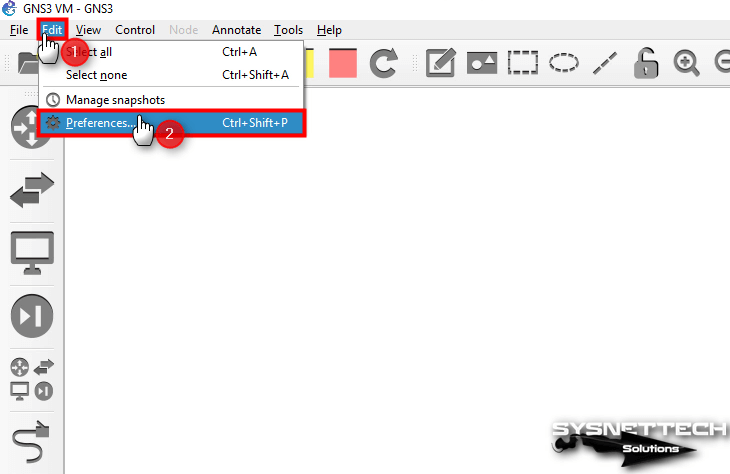

- WHERE DOES GNS3 VM INSTALL TO HOW TO
- WHERE DOES GNS3 VM INSTALL TO SOFTWARE
- WHERE DOES GNS3 VM INSTALL TO SIMULATOR
- WHERE DOES GNS3 VM INSTALL TO DOWNLOAD
- WHERE DOES GNS3 VM INSTALL TO MAC
WHERE DOES GNS3 VM INSTALL TO DOWNLOAD
Select the image version for the appliance and click the Download button. To import the appliance select FILE > Import Appliance and open the gns3a file. Just select one, click download and you gat a gns3a template file. You can add many appliances/devices to GNS3. On the second page, confirm teh configuration of the local server. In this case I will select “Run the appliances on my computer”. Here you can select where you want to run the server somponent. When you first start the GNS3 the Setup Wizard starts. sudo apt install wireshark realvnc-vnc-viewer x11vnc dynamips ubridgeįinally, add your user to the following groups: for i in ubridge libvirt kvm wireshark docker do To be able to capture GNS3 packets for analysis, you need Wireshark. Sudo apt-get install apt-transport-https ca-certificates curl \ To install Docker CE sudo apt remove docker docker-engine docker.io If you want IOU support sudo dpkg -add-architecture i386
WHERE DOES GNS3 VM INSTALL TO SIMULATOR
Install Latest GNS3 Network Simulator on Ubuntu 20.04|18.04|16.04 sudo add-apt-repository ppa:gns3/ppa The ser ver can be a local GNS3 server in a GNS3 VM or on a Remote host. When you create topologies in GNS3 GUI client the created device need to run on the server.
WHERE DOES GNS3 VM INSTALL TO SOFTWARE
GNS3 consists of two software components the GNS3-all-in-one software GUI client and the server. GNS3 allows you to run a small topology consisting of only a few devices on your laptop, to those that have many devices hosted on multiple servers or even hosted in the cloud.
WHERE DOES GNS3 VM INSTALL TO HOW TO
In this post, we show how to install and set up GNS3 and VirtualBox to emulate a network consisting only of open-source routers and hosts.GNS3 is used by hundreds of thousands of network engineers worldwide to emulate, configure, test and troubleshoot virtual and real networks. While there are many web sites and online tutorials dedicated to using GNS3 to emulate Cisco networks and Juniper networks, I found only a small amount of information about using GNS3 to emulate a network of Linux virtual machines running open-source routing and switching software. Our interest is to emulate networks of open-source routers and switches using open-source technologies. GNS3 also supports other hardware emulation and virtualization technologies that can run Linux virtual machines: Qemu and VirtualBox. GNS3 supports Cisco router software images running on the Dynamips hardware emulation program. GNS3 is primarily used to emulate networks of Cisco routers and is used by professionals studying for Cisco certification exams.
WHERE DOES GNS3 VM INSTALL TO MAC
GNS3 is a very popular network simulation tool that runs on the major operating systems: Windows, Mac OS, and Linux.

In this post, we discuss the Tin圜ore Linux system architecture and how to save configuration changes. Or, we may wish to build a complex simulation scenario that will be re-used by other researchers. For example, we may wish to have a basic network configuration working at start time. However, in some cases we may want to save the configuration changes we make.

This means the same appliance can be reused in new simulation scenarios without having to clear configurations that may be left over from a previous simulation effort. When used as part of an open-source network simulator, the Tin圜ore Linux appliance can be restored to a base configuration every time it is started. Viruses or file corruption can be removed simply by rebooting the system.

All changes made to a running Tin圜ore Linux system exist only in system RAM and are lost when the system restarts or is shut down. Tin圜ore Linux is very suitable for devices like routers that require a higher level of security. I use VirtualBox in this example, but any other virtual machine manager would also be suitable. This post lists a detailed procedure to install dCore Linux on a virtual disk image connected to a virtual machine. Currently available instructions for installing dCore Linux onto a hard drive are incomplete and hard to follow. This should simplify the process of building network appliances for use in a network emulator, as you will not need to compile and build your own extensions, or use out-of-date pre-built extensions.ĭCore Linux is designed to run as a “live” Linux system from removable media such as a CD or a USB drive but, for my use, I need to install it on a hard drive. Like Tiny Core Linux, dCore loads its file system entirely into RAM, which should provide good performance in large network emulation scenarios running on a single host computer.ĭCore Linux allows users to install additional software from the Debian or Ubuntu repositories, instead of using the pre-built (and often out-of-date) TCE extensions provided for Tiny Core Linux. DCore Linux is a minimal Linux system based on the Tiny Core Linux system.


 0 kommentar(er)
0 kommentar(er)
